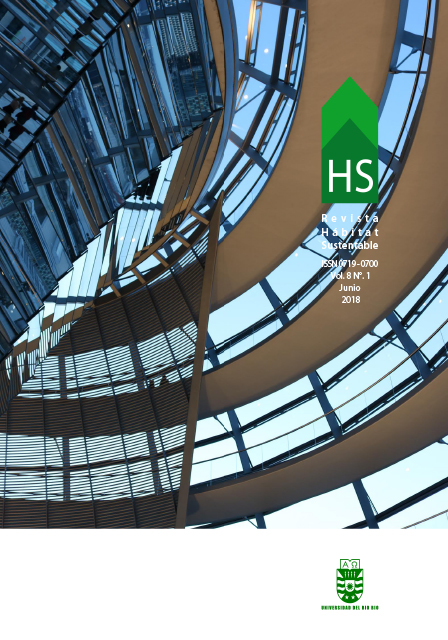Aspectos cuantitativos y cualitativos de la luz solar en recintos urbanos de alta densidad edilicia en climas soleados (período invernal)
DOI:
https://doi.org/10.22320/07190700.2018.08.01.02Palavras-chave:
comportamiento de la luz solar, espacios abiertos, morfología urbana, confort visualResumo
La ciudad de Mendoza, situada en la región centro-oeste de la República Argentina, corresponde a un clima semiárido por lo que presenta elevados niveles de radiación solar a lo largo del año. Sin embargo, estos efectos se ven mitigados por la densidad edilicia y por los períodos de foliación del arbolado urbano. Por esto, el objetivo del presente trabajo es realizar el estudio cuantitativo y cualitativo de las condiciones lumínicas durante el invierno. Se propone el abordaje de luz natural en dos casos de estudio característicos de la ciudad, mediante técnicas combinadas de mediciones in situ y valoraciones subjetivas de los usuarios de los espacios. Los resultados obtenidos de confort visual en espacios exteriores han determinado que más allá de las diferencias lumínicas de los espacios, los sujetos se encuentran adaptados al clima luminoso de la región, a las diferentes condicionantes que genera la morfología urbana y, consecuentemente, a la diversidad de contrastes que esta puede arrojar en el espacio urbano.
Downloads
Referências
BROTAS, Luisa y WIENOLD, Jan. Solar reflected glare affecting visual performance. En: Windsor Conference: Counting the Cost of Comfort in a Changing World. Cumberland Lodge, Windsor Park, UK, London, 2014, Volume: In proceedings, pp. 688-693.
CANTÓN, María Alicia; CORTEGOSO, José Luis y DE ROSA, Carlos. Solar permeability of urban trees in cities of western Argentina. Energy and Buildings, 1994, n° 20, pp. 219-230.
COMISIÓN INTERNACIONAL D’ ECLAIRAGE (CIE). Collection on Glare 2002: Equation for disabilityglare, 146 CIE C 1-50 report and Glare from small, large and complex sources, 147 CIE TC 3-01 report Comission Internationale de Léclairage.
COMPAGNON, Raphaël. Solar and Daylight availability in urban areas. PRECis project Final Technical Report, Ecole d’ingénieurs et d’architectes de Fribourg, 2000.
COMPAGNON, Raphaël. Solar and daylight availability in the urban fabric. Energy and Buildings, 2004, n°36, pp. 321–328.
COMPAGNON, Raphaël y GOYETTE-PERNOT, Joëlle. Visual comfort in urban spaces. En: ROGORA, Alessandro y DESSÌ, Valentina. Il comfort visivo negli spazi urbani. Monfalcone (Gorizia): EdicomEdizioni, 2003, pp. 63-73.CÓRICA, Lorena. Comportamiento de la luz natural en entornos urbanos representativos del modelo oasis en regiones áridas. Caso de estudio: ciudad de Mendoza. Tesis doctoral. Departamento de Luminotecnia, Luz y Visión Herberto Büller. Tucumán, Universidad Nacional de Tucumán, 2010.
CÓRICA, Lorena y PATTINI Andrea. Protocolo de mediciones de iluminación natural en recintos urbanos. Avances en Energías Renovables y Medio Ambiente, 2005, vol. 3, no 2, pp. 05.85- 05.90.
FONTOYNONT, Marc; TSANGRASSOULIS, Aris y SYNNEFA, Afroditi. Daylighting. In: SynthLight Handbook. Bruselas: Eurepean Comision, 2004.
GAITANI, Niki; MIHALAKAKOU, G., y SANTAMOURIS, Mattheos. On the use of bioclimatic architecture principles in order to improve thermal comfort conditions in outdoor spaces. Building and Environment, 2007, n°42, pp. 317-324.
GOYETTE, Joëlle y COMPAGNON, Raphaël. RUROS - Rediscovering the Urban Realm and Open Spaces Project: two case studies in Fribourg, Switzerland. En: ICUC-5 Fifth International Conference on Urban Climate, Lodz, Poland, 2004.
GUTOROV, Mikhail. Srednjaja cilindriceskaja osvescesnost (Die mittlere zylindrische Beleuchtungsstärke), Svetotechnika 9, 1963, no 10, pp. 10-13.
GUZOWSKI, Mary. Dayligthin for sustainable design. New York: McGraw Hill, 2001.
INANICI, Mehlika y GALVIN, Jim. Evaluation of High Dynamic Range photography as a luminance mapping technique. LBNL Report no 57545, Berkeley: Lawrence Berkeley National Laboratory, 2004.
ROMBAUTS, Patrick; VANDEWYNGAERDE, Hans y MAGGETTO, Gaston. Minimum Semicylindrical Illuminance and Modelling in Residential Area Lighting. Lighting Research and Technology, 1989, vol. 21, no 2, p. 49-55.
TREGENZA, Peter. Mean daylight illuminance in rooms facing sunlit streets. Building and Environment, 1995, vol. 30, no 1, pp. 83- 89.
TSANGRASSOULIS, Aris; SANTAMOURIS, Mattheos; GEROS, Vasilis; WILSON, Michael y ASIMAKOPOULOS, Dimosthenis. A method to investigate the potential of south-oriented vertical surfaces for reflecting daylight onto oppositely facing vertical surfaces under sunny conditions. Solar Energy, 1995, vol. 66, n°6, pp. 439-446.
TUMINI, Irina. El microclima urbano en los espacios abiertos. Estudio de casos en Madrid. Tesis doctoral. Escuela Técnica Superior de Arquitectura-Universidad Politécnica de Madrid. Madrid, España, 2012.
Downloads
Publicado
Como Citar
Edição
Secção
Licença
O conteúdo dos artigos publicados em cada número do Habitat Sustentável é da exclusiva responsabilidade dos autores e não representa necessariamente o pensamento ou compromete a opinião da Universidad del Bío-Bío.
Os autores mantêm os seus direitos de autor e concedem à revista o direito de primeira publicação da sua obra, que está simultaneamente sujeita à Licença de Atribuição Creative Commons CC BY-SA que permite a outros partilhar, transformar ou criar novo material a partir desta obra para fins não comerciais, desde que a autoria e a primeira publicação nesta revista sejam reconhecidas, e as suas novas criações sejam licenciadas sob os mesmos termos.











 Programa de Informação Científica/Concurso Fondos de Publicación de Revistas Científicas 2018/ Proyecto Mejoramiento de Visibilidad de Revistas UBB (Código:FP180007)
Programa de Informação Científica/Concurso Fondos de Publicación de Revistas Científicas 2018/ Proyecto Mejoramiento de Visibilidad de Revistas UBB (Código:FP180007)





